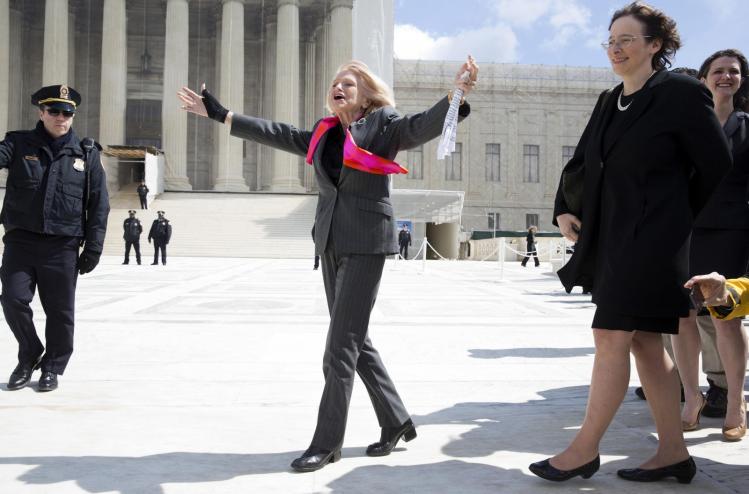
For the past decade I have helped organize an annual roundtable of law and religion scholars. Some years back, I complained half-jokingly to my fellow organizers that the roundtable was too nice. Most conferees shared some basic premises—in particular, that religious belief is important and deserves both respect and substantial legal protection. While that made the conference more pleasant, it removed the sense of fierce conflict that drives debates over law and religion in a wider world that is often indifferent or even hostile to religion and religious liberty. I asked: “Can’t we all just not get along?”
Well, I got my wish. In recent years disagreement has become more heated, as views about religion have changed and conflicts involving same-sex marriage and LGBTQ rights have soared to the top of the religious-freedom agenda. The cast of characters at our roundtable has also changed. Law professors who focus on the Constitution’s equality protections, with religion only a secondary topic of interest, are now as frequent as religion scholars for whom equality is just one consideration. The days of shared premises are gone. The room now comprises two camps—one focused on religion, the other on equality—competing to set the terms of engagement preemptively. For better or for worse, our roundtable has become more reflective of the wider debate.
One of my co-organizers for this event is Nelson Tebbe, a professor at the Brooklyn and Cornell law schools, and author of the important new book Religious Freedom in an Egalitarian Age. Although Tebbe is clearly aligned with the “egalitarian” camp, he respects religion and religious freedom. That respect makes his book a useful, approachable introduction to the new egalitarian thinking driving so much social and legal conflict over religious liberty today.
It helps that Tebbe does not think the conversation is advanced by simply placing scare quotes around the phrase “religious freedom.” Unlike Martin Castro, the former chairman of the United States Commission on Civil Rights, he does not dismiss “religious freedom” as a code for “discrimination, intolerance, racism, sexism, homophobia, Islamophobia or any form of intolerance.” Egalitarians should welcome a book that does not reject the meaningfulness of religious exercise and community. Religious libertarians should appreciate engaging with someone who does not simply rule them out of bounds from the start. That makes the book cause for hope. But not enough hope, in the end.
Despite its focus on reasoned elaboration, a certain magical thinking drives this book, with its relentless mixture of is and ought. “We should insist both that current conflicts between religious freedom and equality law are intricate and that they are not intractable,” Tebbe writes. “Justified solutions can and must be found.” Readers may rightly worry about words like “should” and “must.” That we face urgent problems is no guarantee that we can find a way to “diminish or dissolve the apparent tension between peace and justice” in this area. But Tebbe wants lasting solutions; and though he insists that his book “is not a recipe for the end of disagreement,” he advocates a method, and a set of outcomes, that will “shape civil rights law and religious freedom guarantees into the future.” Like the warring camps at our law and religion roundtable, he wants to set the terms of engagement and treat certain “settlements” as final. The losers should not only “understand why their arguments have been rejected,” but accept defeat with good cheer.
That seems unlikely—and not only because some will reject Tebbe’s proposed outcomes on issues such as the contraceptive mandate, religious accommodations, religious associational freedom, and the reach of nondiscrimination law. More important is the method he relies on for resolving these issues. That method is labeled “social coherence.” Despite Tebbe’s reluctance to say so explicitly, it is essentially a fairly aggressive form of political liberalism. Its aim is to provide a way of addressing not only current conflicts between religious liberty and equality, but “questions of law and political morality” in general. Central to the method is the importance of “warranted” conclusions: conclusions “backed by reasons.” Tebbe holds that if we can come up with “ways of discussing complicated questions of constitutional law, about which there are strong convictions on both sides, in a reasoned way”—a way that leads to what he considers non-arbitrary judgments—then the outcomes should be acceptable to both sides.
Expecting dissenters to accept particular outcomes, which ultimately involve the imposition of coercive state power, because they are “reasoned” or “warranted” is itself an unreasonable expectation. It is a low bar, after all. Practicing lawyers, with their quiver of rhetorical skills and argumentative “reasons” plucked from history, analogy, and legal precedent, understand this. Sometimes they buy their own arguments and convince themselves that they deserve to win; but this is not a requirement. Law is always revisable, always dependent on current social phenomena and an ever-shifting consensus—the courts may hold that the Constitution requires same-sex marriage, but that decision would be meaningless in the absence of changes in public consensus on the issue—and it is mostly concerned with achieving working solutions, not a final state of abstract “justice.” But law professors, whose worldview revolves around their skill in mustering and parsing arguments, often fall prey to an excessive faith in reasons—especially their own. Legal academics are bedazzled by reason.
More dangerous still are those legal academics committed to advocacy. They believe sincerely in the power of reason, even as they use their skills as advocates, writers of amicus briefs, and authors of tweets and op-eds to ensure victory. In seeking to enforce their academic “oughts,” they move from the academy into the public arena, routinely working the refs in varied traditional and social media. Their rhetorical skills may win individual battles. But reason does not end wars. In the meantime, their advocacy contributes to the erosion of public and professional trust in the very “reason” in which they place their faith. That a lawyer can come up with “warranted” explanations for a suggested outcome is no surprise—but neither does it typically resolve disagreement. Advocates on the other side of these battles have their own store of “warranted” arguments. They won’t accept unwelcome outcomes simply because some “expert” fetches up a legal or philosophical justification for them. Courts occasionally change minds, but rarely move hearts and souls.
This reality is not merely the product of a newly polarized, populist, “post-truth” society. It has been so at least since the breakdown of the mid-century “consensus era,” in which a broad range of governing elites shared both common values and the common faith that technocrats could implement these values wisely. And the problem is only amplified when lawyers purport to act not only as legal technicians but as moral philosophers, wantonly mixing and fusing law, legal theory, and moral theory, until one is never sure which tool is being used (or ignored) in order to reach some preordained outcome.
Such is Tebbe’s method in his new book. When legal precedent will get him where he wants, he describes it as “settled” precedent or the “consensus” view. When it won’t, he draws on moral or legal theory to argue that some precedent is inconsistent with larger “principles,” or to stretch a judicial decision by asserting that moral theory reveals its “deeper” implications. He notes, for example, that the so-called “endorsement test” under the Establishment Clause, which asks whether a government action sends a message of civic exclusion to religious outsiders, is “besieged” in the courts, but concludes confidently that it is still “the best understanding of constitutional law.” As lawyers do, he relies regularly on legal and historical analogy—perhaps the weakest and most suspect of all legal and philosophical tools, given its malleability and present-oriented bias.
The result is a confidently stated set of “principles” and outcomes. They may be coherent, but that’s not a difficult standard to achieve, given Tebbe’s willingness to move between high principle and narrow legal reasoning as needed and his tendency to rely on the shared premises of an audience of sympathetic readers. His project may be undertaken in good faith and without cynicism. But it need not convince anyone, either as an abstract matter or in particular cases.
Tebbe argues that finding “rationally justifiable” arguments will answer skeptics (like me) who believe that religious liberty and equality are incommensurable goods, and that conflicts between them are incapable of final resolution. I’m not convinced. No scale has yet been invented, for instance, to weigh the value of religious or associational freedom against the value of nondiscrimination. There may be islands of peace and consensus in the stream of history, but not because “reason” prevailed. The stream always rushes on, and what is incontestable or unthinkable today will be a live issue tomorrow. Tebbe argues that “[s]kepticism is not the only available response to the current conflagration—and it should not be seen as the most attractive one.” But attractiveness is not proof. Skepticism isn’t pretty, but it’s not wrong either.
Consider some of the principles he comes up with to “guide our thinking about conflicts between religious freedom and equality law.” Tebbe identifies “four primary commitments that run through defensible constitutional decisions in this area.” They are sound enough, broadly speaking. In keeping with his general method of moving between legal precedent and moral and legal theory, however, he applies either one or the other, broadly or narrowly, as the need arises—sometimes pounding the table with precedent, and sometimes describing or distinguishing particular legal decisions “on the level of general values.” He nonetheless insists that his principles “are not vague ideals or aspirations. They have the status of constitutional law.” I am not clear what this adds, other than the ability to back his recommended outcomes with state power. Law after all is a collection of holdings that can be altered or reversed. The “principles” discerned behind them may provide a foothold for the next decision, but are not themselves “law” in any useful sense. And the more they are abstracted from the cases they inform, the less likely they are to have any clear legal status at all. They are just arguments: “warranted” ones perhaps, but neither binding nor final.
Thus, Tebbe argues that a central animating principle of law and religion is “avoiding harm to others,” meaning that while religious accommodations whose costs are borne by the state are permissible, government cannot make others bear the costs of religious accommodation. The usual citation for this principle is Estate of Thornton v. Caldor, in which the Supreme Court struck down a state statute that allowed all employees to take off the Sabbath day of their choice. The Court said the law violated the Establishment Clause because it applied an “unyielding weighting in favor of Sabbath observers,” and thus imposed an “absolute” requirement on employers and employees, “no matter what burden or inconvenience this imposes on the employer or fellow workers.” In other words, religious accommodations that impose third-party costs, with no consideration whatsoever of competing interests, are unconstitutional.
This is quite different from Tebbe’s emphatic “principle” that religious accommodations “may not shift meaningful costs to others,” period. Tebbe argues that the Court erred in its Hobby Lobby decision because the accommodation accepted by the Court for employees who wanted insurance coverage for contraception would take time to set up, and thus have some impact on employees. Maybe so. But such cases could also be read to suggest a narrower understanding of any “rule” against third-party harm, one which requires some balancing of interests rather than unyielding accommodation. That balancing is arguably already provided by the statute in Hobby Lobby, the Religious Freedom Restoration Act, itself.
I won’t rehash that debate here. (Although readers shouldn’t naively assume, just because it has been pressed ardently on Twitter, that the strong version of the “no harm to third parties” argument is an accurate statement of “the law.”) My point is that what it means for this or that principle to “have the status of constitutional law” is a difficult question even when it’s confined to legal texts. When one also adds to those legal holdings a variable mix of moral and legal theory, one soon recognizes that the mere fact of a particular legal argument being “warranted” can’t be expected to quell social and legal conflict. Lawyers and law professors know this, even if they pretend otherwise. General readers should not be blinded by the invocation of this or that principle as having “the status of constitutional law.” And “no harm to third parties” isn’t even the most controversial of Tebbe’s four “principles.”
I will glide over the outcomes Tebbe counsels in specific disputes, such as the wedding-cake case; readers interested only in concrete results may read the book to find out what they are. Tebbe points out that some of his recommendations will be unexpected. That’s true—at least insofar as the “social coherence” method (in his hands, anyway) can lead to occasional results “that [hard-core] progressives might not reflexively adopt.” Tebbe is an assertive egalitarian, but no absolutist. Nor does he simply sneer at religious belief and practice. That is why, despite my disagreements with the book, I consider it a genuine contribution to the current discussion, and one of the more thoughtful statements of the egalitarian side of the “equality” vs. “religious liberty” debate.
Still, it’s worth noting that anyone can find “warranted” grounds for particular results in that debate. Neither the Republican nor the Democratic Party platform committees needed the aid of a legal or political theorist to do so. That those platforms could be backed by reasons did little to make converts, and nothing to bridge the gulf between the two camps. The fact that some position represents a legal or social “consensus” or “settlement” only means it may succeed in being backed by force if need be, not that anyone needs to accept it with good will—especially if one is watching the political changing of the guard and the restaffing of the Supreme Court, and suspects that “warranted” arguments for a more aggressively libertarian and less forcefully egalitarian approach to the Religion Clauses are on the way.
Social peace and legal clarity are good things, to be sure. But unlike Nelson Tebbe, I doubt that the mere presence of “warranted” arguments is the coin that will buy them.
Religious Freedom in an Egalitarian Age
Nelson Tebbe
Harvard University Press, $39.95, 288 pp.
Please email comments to [email protected] and join the conversation on our Facebook page.
Share
Previous Story
Taunting a Tyrant
Next Story
Poem | Old Miami

